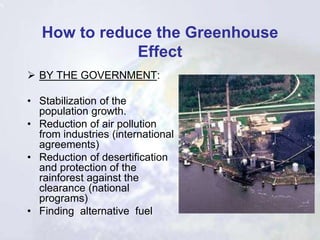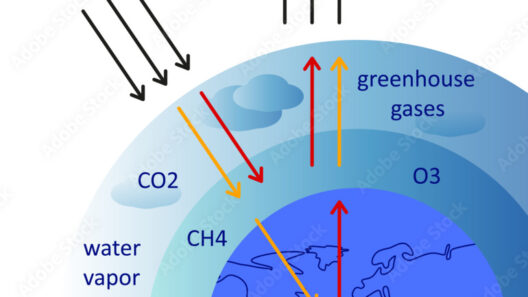Reducing the greenhouse effect is a paramount challenge in our contemporary world, necessitating concerted efforts from individuals and communities alike. As global temperatures rise and climate patterns shift, it is imperative that we adopt actionable strategies to mitigate our carbon footprints and promote sustainability. This article outlines several practical steps that can be taken collectively and individually to decrease the greenhouse effect and combat global warming.
Understanding the Greenhouse Effect
The greenhouse effect is a natural phenomenon where certain gases in the Earth’s atmosphere trap heat, preventing it from escaping back into space. This process is essential for maintaining life on Earth, as it keeps our planet warm enough to support ecosystems. However, human activities, particularly the burning of fossil fuels, deforestation, and industrial processes, have led to an excessive accumulation of greenhouse gases like carbon dioxide (CO2) and methane (CH4). This enhanced greenhouse effect exacerbates global warming and climate change.
Embrace Energy Efficiency
One of the most effective ways to decrease the greenhouse effect is through energy efficiency. By utilizing energy in a more judicious manner, we can significantly reduce our dependence on fossil fuels.
Maximize Appliance Performance
Investing in energy-efficient appliances can yield substantial savings on electricity bills while simultaneously reducing greenhouse gas emissions. Look for Energy Star-rated products that consume less energy without compromising performance. Furthermore, regular maintenance of heating and cooling systems ensures they function optimally, minimizing energy waste.
Enhance Home Insulation
Improving insulation in homes can drastically curb heating and cooling needs. Sealing windows and doors, adding insulation in attics, and using weatherstripping can help maintain internal temperatures while lessening the reliance on energy-consuming systems.
Transition to Renewable Energy
Shifting to renewable energy sources, such as solar, wind, and hydroelectric power, can dramatically reduce our carbon footprints. For instance, installing solar panels not only provides clean energy but can also lower utility bills in the long term. Many local governments offer incentives to encourage the adoption of renewable energy alternatives, making it more accessible for homeowners.
Transform Transportation Practices
Transportation is a major contributor to greenhouse gas emissions. Rethinking how we commute can have profound implications for the environment.
Opt for Sustainable Modalities
Choosing public transportation, carpooling, biking, or walking minimizes the number of vehicles on the road. Electric vehicles (EVs) are another promising solution; they emit no tailpipe emissions and are increasingly powered by renewable energy, further reducing their environmental impact. For shorter distances, consider biking or walking to reduce carbon emissions entirely.
Rethink Travel Habits
Air travel significantly contributes to greenhouse gas emissions. Limiting air travel or choosing alternatives like train travel when possible can help mitigate this impact. When flying is unavoidable, consider offsetting your carbon emissions by supporting projects that reduce greenhouse gas emissions elsewhere.
Adopt a Sustainable Lifestyle
Individuals can embed sustainability into their everyday lives through conscious consumption and mindful living.
Reduce, Reuse, and Recycle
Curbing consumption by embracing the principles of reducing, reusing, and recycling can limit the amount of waste generated. By opting for products with minimal packaging or those made from recycled materials, we lessen the energy required for manufacturing and disposal processes.
Embrace Plant-Based Eating
The agricultural sector is a significant contributor to greenhouse gas emissions, particularly from livestock production. Adopting a plant-based diet, even partially, can lower your carbon footprint. By reducing meat and dairy consumption, individuals can contribute to less methane production and decrease the overall demand for resource-intensive animal farming.
Support Local and Organic Products
Choosing local and organic foods reduces the carbon footprint associated with transportation and chemical fertilizers, respectively. When shopping, consider visiting local farmers’ markets and supporting food producers dedicated to sustainable practices.
Raise Awareness and Advocate for Change
Beyond personal actions, community engagement and advocacy are crucial for systemic change. Voices advocating for climate solutions can galvanize collective efforts that lead to meaningful policy reforms.
Educate Others
Informing friends, family, and your community about the climate crisis and sustainable practices can initiate a ripple effect. Hosting workshops or community discussions can empower others to take action and inspire a collective commitment to sustainability.
Engage with Policymakers
Advocacy for meaningful climate policies enhances accountability from governments and corporations. Engage with local representatives, attend town hall meetings, and support organizations that focus on environmental legislation. Collective voices urging sustainable practices can lead to substantial policy changes aimed at reducing greenhouse gas emissions.
Conclusion: Every Action Counts
Addressing the greenhouse effect and global warming may seem daunting, but every action counts. By adopting energy-efficient practices, transforming transportation habits, embracing sustainable lifestyles, and advocating for systemic change, we can collectively work towards a healthier planet. Each small step taken by individuals and communities contributes to mitigating climate change, repairing ecosystems, and safeguarding our environment for future generations. It is our shared responsibility to combat the challenges posed by the greenhouse effect and foster a sustainable world.





